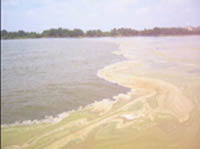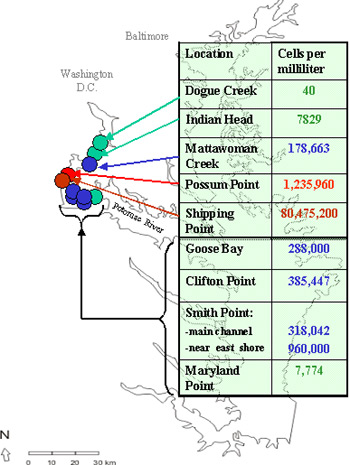|
||||||
Routine water quality monitoring by the Maryland Department of Natural Resources (DNR) and the Academy of Natural Sciences Estuarine Research Center (ANSERC) detected blue-green algal bloom waters Monday and Tuesday, July 19-20, over approximately 15 miles of the Potomac River and its tributaries largely bordering Charles County, MD (Figure 1). The greatest abundance of the possibly toxic cyanobacteria (i.e., blue-green algae) Microcystis was measured outside the main channel off the mouth of Quantico Creek at Shipping Point with 80,475,200 cells per milliliter (Figure 1). Similar looking bloom waters were observed near Mallows Bay.
Microcystis measured in the main channel of the river at long-term Chesapeake Bay water quality monitoring stations was most abundant at three sites: 178,663 cells per milliliter at Mattawoman Creek, 1,235,960 cells per milliliter at Possum Point and 318,042 cells per milliliter at Smith Point. Outside the main channel at Smith Point ANSERC measured a sample with 960,000 cells per milliliter Microcystis while at Clifton Beach near Smith Point, an algal sample measured 385,447 cells per milliliter. The cyanobacteria Anabaena and Aphanizomenon were present in very low abundance (less than 318 organisms per milliliter) in samples between Dogue Creek and Possum Point. Cell abundances less than 10,000 cells per milliliter of Microcystis were detected upstream of Mattawoman Creek to the area of Dogue Creek and downstream of Smith Point to Maryland Point, covering an overall distance of approximately 30 miles. Water quality at the Continuous Monitoring stations for Mattawoman Creek and Fenwick on the Potomac this week showed conditions coincident with the algal blooms: high dissolved oxygen levels (greater than 10 mg oxygen per liter, normal 6-7), high dissolved oxygen saturations (greater than 150%, normal 100%) and elevated pH (greater than 9, normal around 7). Concentrations of cyanobacteria have been increasing and expanding their
distribution in the Potomac River since they were first observed during
late spring on June 7. A Mattawoman Creek sample that day measured 34,450
cells per milliliter and Sandy Point (upstream of Mallows Bay) had 2.4
million cells per milliliter. In late June and early July high abundances
led to beach closures by Virginia
Department of Environmental Quality downstream of the Route 301 Bridge at Colonial Beach, VA. On July 3,
the beach reopened with subsequent declines in Microcystis. However,
Maryland DNR detected widespread presence of Microcystis on July 6 upstream
of the Route 301 Bridge, the precursor to the extensive blooms being
observed this week. Pockets of blue-green
algal blooms may be encountered during boating and other recreational
activities. People should take common precautions to reduce the risk of
illness or discomfort related to blue-green algal blooms:
Please note that illness associated with harmful algal blooms is now a reportable illness so physicians should be reporting these to local health departments. The MD DNR in coordination and cooperation with DHMH and MDE will continue to monitor all blue-green algal blooms throughout the state. For up to date information on all of Maryland's harmful algal blooms and water quality, please visit Eyes on the Bay |




